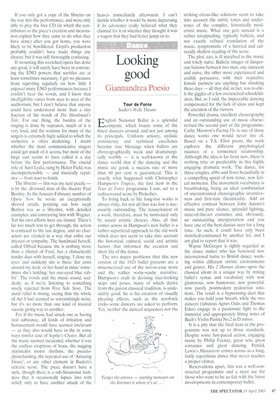Looking good
Giannandrea Poesio
Tour de Force Serdler's Wells Theatre
-'nglish National Ballet is a splendid ..I_company, which boasts some of the finest dancers around, and not just among its principals. Uniform artistry, stylistic consistency and technical excellence become true blessings when ballets are choreographically weak and dramaturgically wobbly — it is well-known in the dance world that if the dancing and the music are good, a success rate of more than 60 per cent is guaranteed. This is exactly what happened with Christopher Hampson's Trapeze, the first item in the Tour de Force programme I saw, set to a rediscovered score by Prokofiev.
To bring back to life long-lost works is always risky, for not all that was lost is necessarily outstanding. The resuscitation of a work, therefore, must be motivated only by sound artistic choices. Alas, all that comes across in Hampson's new ballet is a rather superficial approach to the old work which does not seem to take into account the historical, cultural, social and artistic factors that informed the creation and short life of the dance.
The two major problems that this new version of the 1924 ballet presents are a misconceived use of the not-so-easy score and the rather wishy-washy narrative. Hampson's craft in devising nice-looking steps and poses, many of which derive from the purest classical tradition, is undeniably good. So is his creation of visually pleasing effects, such as the acrobatic tricks some dancers are asked to perform. Yet, neither the danced sequences nor the striking circus-like solutions seem to take into account the subtle tones and undertones of the complex, historically modernist music. What one gets instead is a rather unappealing, typically balletic, and not exactly refined translation of the music, symptomatic of a hurried and culturally shallow reading of the score.
The plot, too, is ill matched to the music and tritely naive. Balletic images of dangerous liaisons between two men, one innocent and naive, the other more experienced and craftily persuasive, with their respective female partners are anything but shocking these days — all they did, in fact, was to elicit the giggles of a few overexcited schoolchildren. But, as I said, the impeccable dancing compensated for the lack of ideas and kept the attention of the viewers.
Powerful drama, excellent choreography and an outstanding use of music characterised the second part of the programme. Cathy Marston's Facing Viv is one of those dance works one would never tire of. Based on a T.S. Eliot poem, the work explores the different psychological nuances of a tormented relationship. Although the idea is far from new, there is nothing trite or predictable in this highly engaging dramatic work. The dance, for three couples, ebbs and flows beautifully in a compelling spiral of now tense, now lyrical moments. The movement vocabulary is breathtaking, being an ideal combination of unconstrained choreographic inventiveness and first-rate theatricality. Add an effective contrast between John Adams's music and pure silence, splendid lighting, state-of-the-art costumes and, obviously, an outstanding interpretation and you have one of the best dances seen for a long time. As such, it could have only been matched/contrasted by another hit, and I am glad to report that it was.
Wayne McGregor is rightly regarded as the dance maker who has bestowed new international lustre to British dance, working within different artistic environments and genres. His 2 Human draws upon the classical idiom in a unique way by mixing ballet's syntax and vocabulary with now glamorous, now humorous, now powerful, now purely postmodern pedestrian solutions. The result is a hypnotising duet that makes you hold your breath, while the two dancers (fabulous Agnes Oaks and Thomas Edur) engage in a passionate fight to the immortal and appropriately fitting notes of Bach's Violin Partita No.2 in D minor.
It is a pity that the final item in the programme was not up to those standards. Despite some fast-paced action, engaging music by Philip Feeney, great sets, great costumes and great dancing, Patrick Lewis's Manoeuvre comes across as a long, fairly repetitious dance that never reaches a proper climax.
Reservations apart, this was a well-constructed programme and a must see for those who want to be au fait with the latest developments in contemporary ballet.


































































 Previous page
Previous page